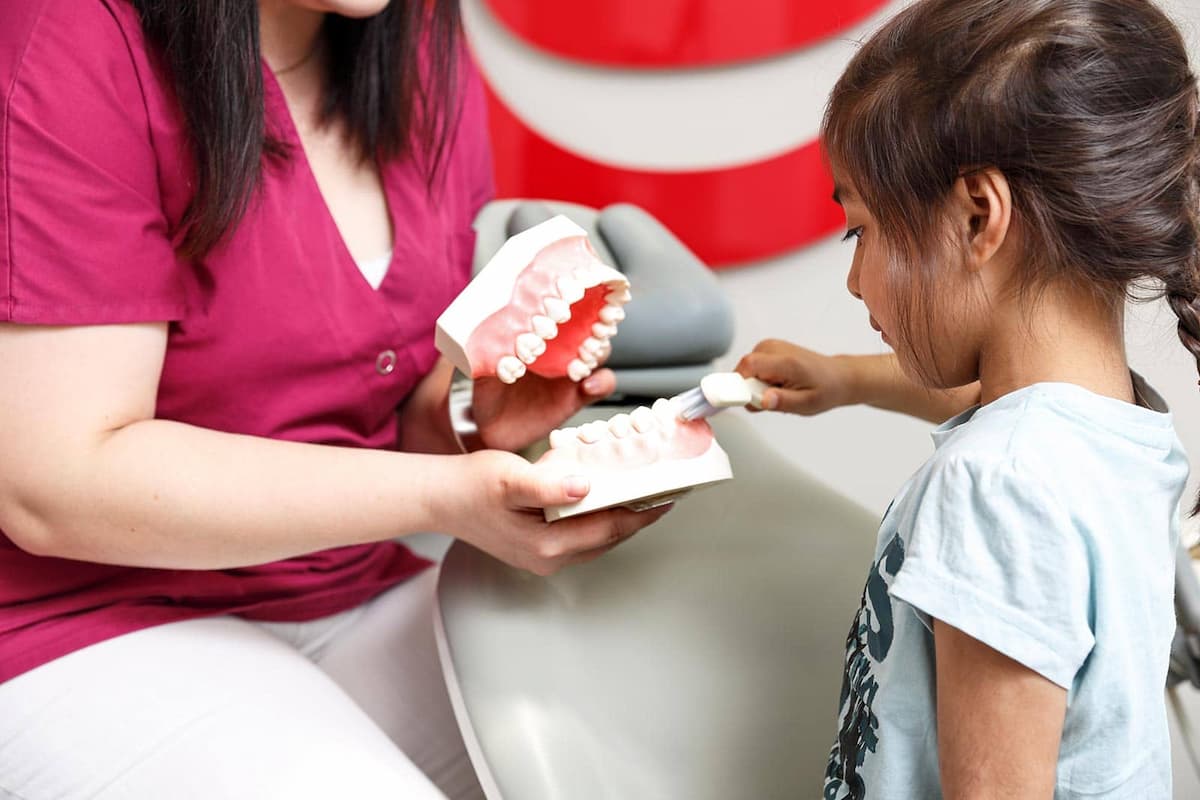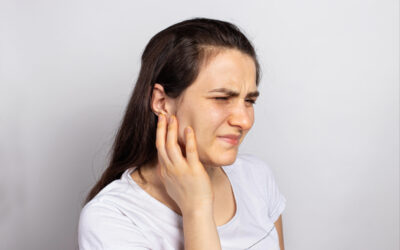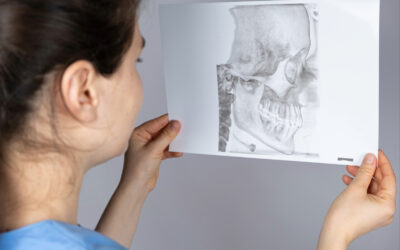KFO-Wörterbuch
Aktivator
Aktive Platte
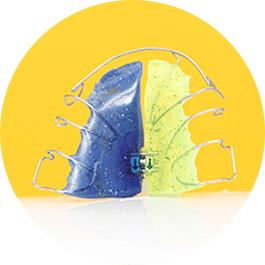
Herausnehmbare Klammer, mit der wir die Zähne aktiv bewegen wollen. Die Bewegung erfolgt hierbei z. B. mit Federn oder Stellschrauben.
Anfärben
Mit einer speziellen Färbeflüssigkeit machen wir die Zahnbeläge im Mund sichtbar. Hierdurch erkennen wir die Bereiche, die nicht ideal geputzt wurden.
ASR
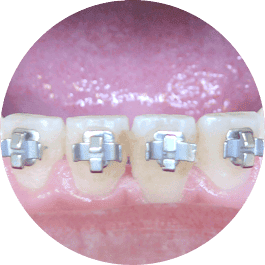
Abkürzung für „approximale Schmelzreduktion“: Liegt ein moderater Platzmangel vor, kann man durch eine gezielte Verringerung des Schmelzmantels einzelner Zähne diesen Platzmangel beseitigen, ohne bleibende Zähne zu entfernen.
Band
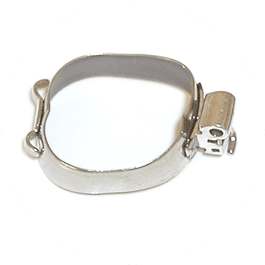
Metallring, der über den Backenzahn geschoben wird. Es dient zur Aufnahme eines Bogendrahts. Hierzu besitzt das Band an der Wangenseite ein entsprechendes Schloss mit unterschiedlichen Schlitzen, in die der Bogendraht reingeschoben wird.
Bogendraht
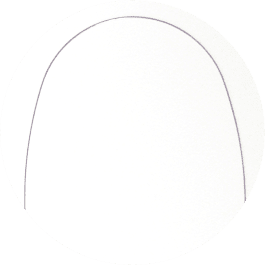
Draht, der durch die Schlitze der Brackets und Bänder verläuft. Die Zähne werden entlang des Bogens bewegt.
Brackets
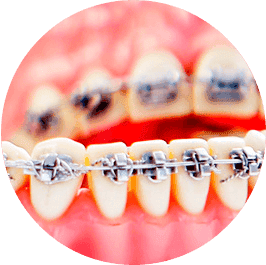
Kleine Klebeteile, die auf die Zähne geklebt werden. Jedes Bracket hat einen Schlitz (slot) durch den der Bogendraht verläuft.
Carrière Distalizer
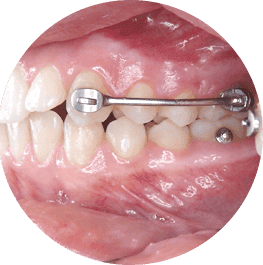
Festsitzende Klammer im Oberkiefer, mit der wir die Backenzähne nach hinten schieben. Damit diese Bewegung funktioniert, müssen Gummizüge vom vorderen Haken des Distalizers zum unteren Backenzahn gespannt werden.
Clear Aligner
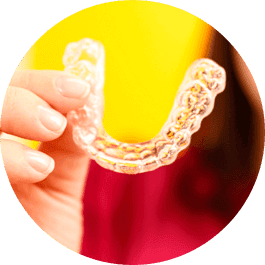
Transparente Schienen, zur Beseitigung einfacherer Zahnfehlstellungen. Diese Schienen werden bei uns hergestellt. Jeder Schienensatz umfasst 2-3 Schienen (soft, medium, hard), mit denen schrittweise eine Verbesserung erzielt wird. Nach jedem Schienensatz nehmen wir einen neuen Abdruck. Je nach Fehlstellung benötigen wir mehrere Schienensätze.
Einschleifen der Schneidekanten
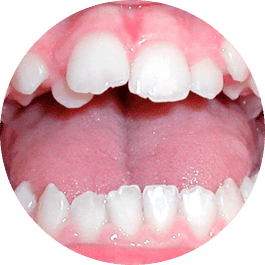
Vor dem Eingliedern der festen Klammer sollten abgebrochene Ecken an den Schneidekanten durch kontrolliertes Einschleifen beseitigt oder reduziert werden.
Elastics
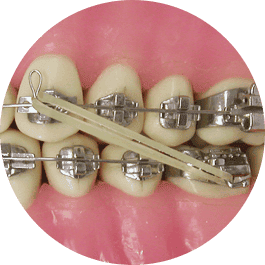
Gummizüge, die der Patient in den Mund einhängt. Von wo nach wo diese Gummizüge einzuhängen sind, hängt von der Behandlungsaufgabe ab. Die Elastics gibt es in unterschiedlichen Größen.
Funktionsanalyse
„FA“ ist unsere Abkürzung für die manuelle Funktionsanalyse, bei der wir das Kiefergelenk und die angrenzende Muskulatur untersuchen. Ergibt diese Untersuchung erhebliche Probleme, so sollte vor der kieferorthopädischen Behandlung eine entsprechende Vorbehandlung erfolgen.
Flecken (Entkalkungen)
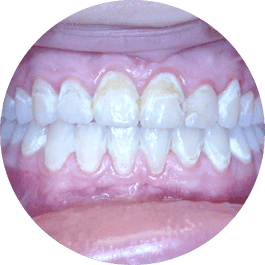
Durch schlechtes Putzen bleibt Belag auf den Zähnen. Dieser ist voller Bakterien, die den Schmelz angreifen. Es entstehen weiße Flecken, die eine Vorstufe von Karies sind. Das bedeutet, die Zähne gehen kaputt, wenn man nicht besser putzt. Dazu spielt die richtige Ernährung eine wichtige Rolle. Softdrinks z.B. enthalten viel Zucker, der zu Schäden führen kann!
Fotos
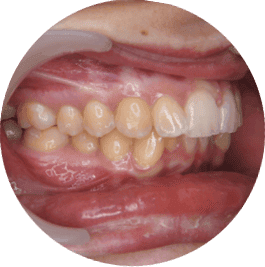
Für eine ideale Fotodokumentation und Auswertung machen wir zu Beginn und am Ende der Behandlung je neun Fotos, je drei außerhalb und je sechs innerhalb des Mundes.
Gosh
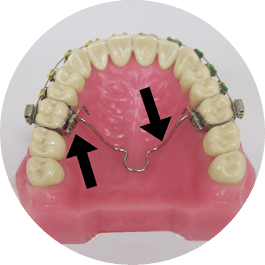
Ist unsere Abkürzung für einen Goshgarian-Bogen. Es handelt sich um einen Gaumenbogen, der den linken oberen Backenzahn mit dem rechten oberen Backenzahn verbindet.
Headgear
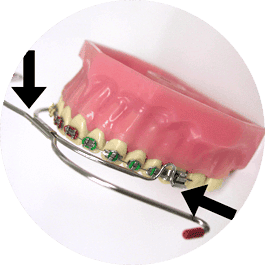
Auch Gesichtsbogen genannt; es handelt sich um einen Bogen, der an den oberen Backenzähnen befestigt wird und zwei Außenarme hat. An diesen Außenarmen wird ein Gummiband befestigt, dass sich entweder am Nacken (Nackenband) oder am Kopf (Kopfhaube) abstützt und das die Backenzähne nach hinten zieht.
Helix
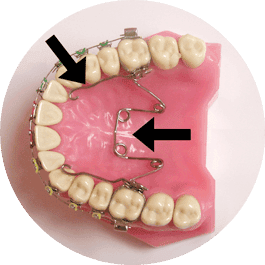
Es handelt sich um einen Gaumenbogen mit vier Schlaufen. Er wird an den Gaumen-Schlössern der oberen Backenzähne befestigt. Er dient der Dehnung der Seitenzähne im Oberkiefer.
Unsichtbare Zahnspange
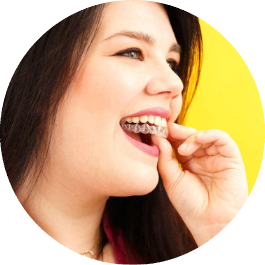
Methode zur Behandlung von Fehlstellungen mit transparenten Schienen. Die Schienen werden nach unseren Vorgaben in den USA computergestützt hergestellt. Die Schienen sind mindestens 22 Stunden pro Tag zu tragen und nach 2 Wochen zu wechseln.
Jasper-Jumper
Hier erfolgt die Vorverlagerung des Unterkiefers durch eine mit Kunststoff überzogene Feder, die im Oberkiefer an den Bändern der großen Backenzähne befestigt wird und im Unterkiefer an einem zusätzlichen Teilbogen im Eckzahnbereich fixiert ist.
Kette
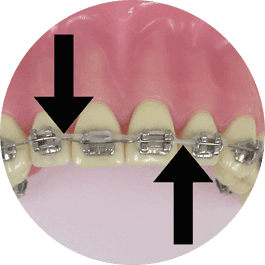
Es handelt sich um eine Gummikette, die in der Lage ist, einen Zahn am Bogen entlang zu bewegen.
Kobayashi
Eine Kobayashi-Ligatur ist ein dünner Draht mit einer Schlaufe. Dieser Draht wird an einem Bracket befestigt. An der Schlaufe der Kobayashi-Ligatur kann ein Gummizug eingehängt werden.
LiBo
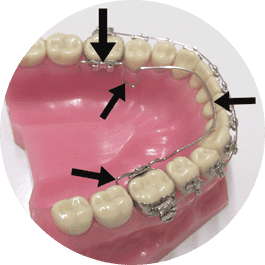
Abkürzung für einen Lingualbogen nach Wilson. Es handelt sich um einen Bogen, der an der Innenseite = lingual der Unterkieferzähne verläuft. Er ist in den Lingualschlössern der unteren Backenzähne befestigt.
Ligatur
Ein dünner Draht, mit dem wir den Bogendraht im Bracket fixieren. Benutzen wir eine Drahtligatur, um einzelne Zähne miteinander zu verblocken, so sprechen wir von einer Achterligatur.
Mini-Schraube
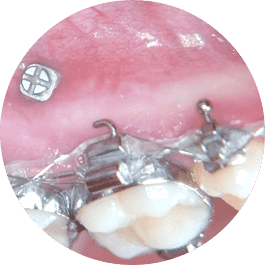
Spezialschraube, die in den Kieferknochen eingedreht wird. Da diese Schraube fest im Knochen verankert ist, kann sie als Widerlager genutzt werden. Nach Ende der aktiven Behandlung wird diese Schraube einfach herausgedreht.
Piercing-Zahnschäden
Schäden durch Piercings entstehen über die Zeit und sind nicht reversibel. Je nach Piercing entstehen Schmelzdefekte, Zahnfleischentzündungen und Zahnfleischrückgang.
Power-Faden
Ein elastischer Faden, mit dem wir Kräfte auf einzelne Zähne einwirken lassen können, z.B. zur Beseitigung von Drehständen.
Quad-Helix
Auch Helix genannt. Es handelt sich um einen Gaumenbogen mit vier Schlaufen. Er wird an den Gaumen-Schlössern der oberen Backenzähne befestigt. Er dient der Dehnung der Seitenzähne im Oberkiefer.
Quickies
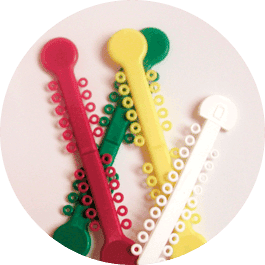
Kleine Gummiringe, die den Bogendraht im Bracket fixieren.
Retainer
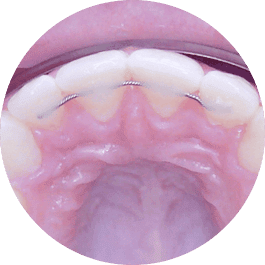
Kleiner Draht, der hinter die vorderen Zähne geklebt wird und von außen nicht sichtbar ist. Er sorgt dafür, dass sich speziell die Schneidezähne nicht wieder drehen können oder dort Lücken aufgehen. Er sollte immer eingeklebt bleiben.
Retentionsplatte
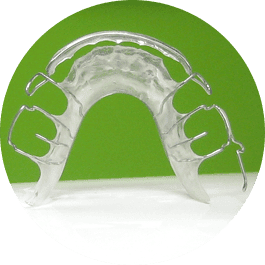
Zum Stabilisieren des Ergebnisses nach erfolgreicher aktiver Behandlung setzen wir herausnehmbare Klammern ein. Diese sind zu Beginn intensiv zu tragen; später reduzieren wir die Tragezeit.
SUS
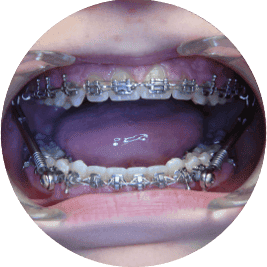
Bei dieser Sabbagh-Universal-Spring-Apparatur erfolgt die Vorverlagerung des Unterkiefers durch ein Teleskop-System, das im Oberkiefer an den Bändern der dicken Backenzähne befestigt wird und im Unterkiefer im Bereich der Eckzähne auf dem vorhandenen Bogen fixiert wird.
Titanbogen

Neben den üblichen Edelstahl-Bögen setzen wir zu Beginn der Behandlung bevorzugt hochelastische Titanbögen ein, die geringere Kräfte entwickeln und somit dazu beitragen, dass die Zähne weniger schmerzempfindlich sind.
Transparente Schiene
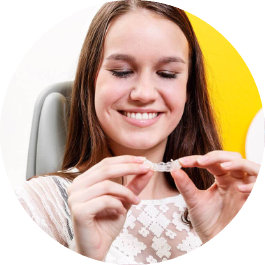
Als Stabilisierungsklammer ist die transparente Stabilisierungsschiene fast nicht zu sehen und behindert das Sprechen kaum.
Twin-Block
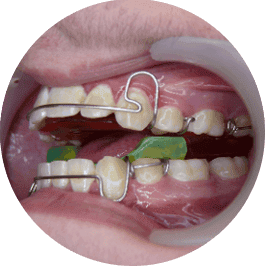
Es handelt sich hier um eine zweiteilige herausnehmbare Klammer, mit der wir die Stufe zwischen den oberen und unteren Frontzähnen verkleinern.
Überlagerung
Durch die Überlagerung von zwei seitlichen Röntgenbildern (z.B. Anfangs- und Zwischen-befunds-Röntgenbild) erhalten wir genaue Informationen über bereits erreichten Veränderungen.
VD-Platte
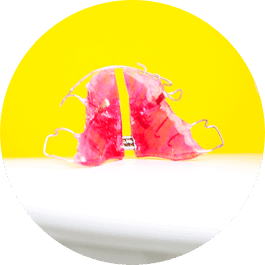
Zweiteilige Klammer zur Verkleinerung des Abstandes zwischen den oberen und den unteren Frontzähnen. Hierzu erhält der obere Teil der Klammer sogenannte Vorschubsporne und der untere Teil der Klammer zwei schiefe Ebenen. Beim Zubeißen gleitet der Unterkiefer an den Vorschubspornen entlang nach vorne.
Versiegeln
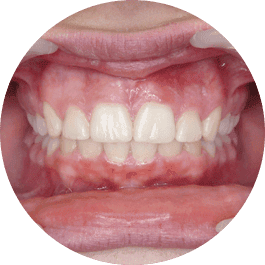
Da das Umfeld der Klebeteilchen während der Behandlung einem verstärkten Säureangriff ausgesetzt ist, empfehlen wir das regelmäßige Auftragen eines Glattflächen-Versieglers bei uns.
Zahnreinigung
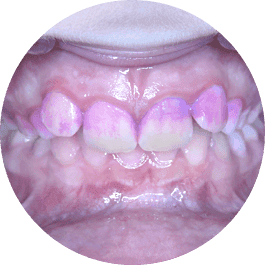
Dabei werden die Zähne Zahn für Zahn intensiv gereinigt – bei hartnäckigen Belägen gegebenenfalls mit einem Pulverstrahlgerät.
Zahnschema
Damit wir jeden Zahn eindeutig zuordnen können, benutzen wir das FDI-Zahnschema. Die 32 bleibenden Zähne (Zahnschema) bezeichnen wir als:
11 – 18 Oberkiefer rechts
21 – 28 Oberkiefer links
31 – 38 Unterkiefer links
41 – 48 Unterkiefer rechts
11 = erster Zahn ab der Mitte im OK rechts = Mittlerer Schneidezahn im Oberkiefer rechts
18 = 8. Zahn ab der Mitte im OK rechts = Weisheitszahn im Oberkiefer rechts
45 = 5. Zahn ab der Mitte im UK rechts
Die 20 Milchzähne (Milchzahnschema) bezeichnen wir als:
51 – 55 Oberkiefer rechts
61 – 65 Oberkiefer links
71 – 75 Unterkiefer links/li>
81 – 85 Unterkiefer rechts
51 = erster Milchzahn ab der Mitte im OK rechts = Mittlerer Schneidezahn im Oberkiefer rechts
55 = 5. Milchzahn ab der Mitte im Oberkiefer rechts
85 = 5. Milchzahn ab der Mitte im Unterkiefer rechts
Mundhygiene: Richtig putzen lernen
Um Schäden an den Zähnen während der Behandlung zu vermeiden, haben wir hier eine Sammlung an Mundhygienehinweisen zusammengestellt.
Putzen mit System
Damit wirklich alle Zahnflächen beim Zähneputzen gereinigt werden, ist es am besten, wenn wir immer in der gleichen Reihenfolge putzen. Dafür einfach den Namen KAI merken: Kauflächen, Außenflächen, Innenflächen.
- Die Kauflächen Unterkiefer: Schrubb-Bewegungen von oben nach unten und von unten nach oben, nacheinander rechts von hinten nach vorne und links von hinten nach vorne. Dann Oberkiefer: nacheinander rechts von hinten nach vorne und links von hinten nach vorne.
- Die Außenflächen Unterkiefer: mit kreisenden Bewegungen von rechts hinten bis zu den vorderen Zähnen, dann von links hinten bis zu den vorderen Zähnen, dann die vorderen Zähne von Eckzahn zu Eckzahn. Dann Oberkiefer: von rechts hinten bis zu den vorderen Zähnen, dann von links hinten bis zu den vorderen Zähnen, dann die vorderen Zähne von Eckzahn zu Eckzahn. Dabei die Zahnbürste beim Seitenwechsel vorne auf einem schon geputzten Bereich ansetzen.
- Zuletzt die Innenflächen Unterkiefer: Die Bürste vom Zahnfleisch zur Kaufläche gleiten lassen, von rechts hinten über die vorderen Zähne bis nach links hinten. Dann Oberkiefer: Die Bürste vom Zahnfleisch zur Kaufläche gleiten lassen, von rechts hinten über die vorderen Zähne bis nach links hinten. Dabei die Zahnbürste im vorderen Bereich senkrecht halten und von Eckzahn zu Eckzahn so putzen.
Wichtig Sowohl mit der Handzahnbürste als auch mit der elektrischen Zahnbürste müssen die gleichen richtigen Putzbewegungen durchgeführt werden! Falls keine feste Klammer vorhanden ist: von rot nach weiß putzen. Dass heißt: vom Zahnfleisch zum Zahn vertikal putzen und zwar jeden Zahn 5 mal. Mit fester Klammer: Rütteltechnik. Das heißt: Zahnbürste im 45° zum Zahnfleisch ansetzen und kleine horizontale Rüttelbewegungen machen.
Es lohnt sich – für gesunde Zähne und ein strahlendes Lächeln!

